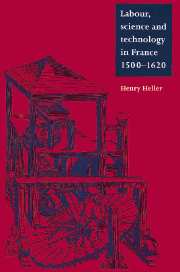Book contents
- Frontmatter
- Contents
- List of illustrations
- Preface
- List of abbreviations
- Introduction
- 1 The expansion of Parisian merchant capital
- 2 Labour in Paris in the sixteenth century
- 3 Civil war and economic experiments
- 4 Inventions and science in the reign of Charles IX
- 5 Expropriation, technology and wage labour
- 6 The Bourbon economic restoration
- 7 Braudel, Le Roy Ladurie and the inertia of history
- Bibliography
- Index
- CAMBRIDGE STUDIES IN EARLY MODERN HISTORY
4 - Inventions and science in the reign of Charles IX
Published online by Cambridge University Press: 01 October 2009
- Frontmatter
- Contents
- List of illustrations
- Preface
- List of abbreviations
- Introduction
- 1 The expansion of Parisian merchant capital
- 2 Labour in Paris in the sixteenth century
- 3 Civil war and economic experiments
- 4 Inventions and science in the reign of Charles IX
- 5 Expropriation, technology and wage labour
- 6 The Bourbon economic restoration
- 7 Braudel, Le Roy Ladurie and the inertia of history
- Bibliography
- Index
- CAMBRIDGE STUDIES IN EARLY MODERN HISTORY
Summary
It is not enough to know how to express the rules of navigation, construction and farming … one must put one's hand to the task …
Ramus, Remonstrance au Conseil Privé (1567)The economic and political crisis into which the French kingdom was plunged in the 1560s spurred technological innovation and economic rationalization. Schemes and proposals to produce more food or to conserve or develop sources of energy were put forward. All kinds of machines and inventions were designed with the intention of producing manufactures which were cheaper and therefore potentially more profitable. A fascination with machinery became pervasive. An inventor came forward to offer the city of Rouen an underground diving bell of his own devising to repair a recently collapsed bridge. The Hermeticist bishop François Foix de Candale spent his leisure contriving all sorts of mechanical devices including wheels, levers and pulleys, clocks and measuring instruments. A mock castle with ninety-nine mechanical artifices toured the kingdom, its mechanically operated cannon, jousting knights, water fountains and windmill astounding the population. The mathematician Henri de Monantheuil, viewing this spectacle, took it as a portent of more important things to come. The monarchy, although hamstrung by its own insolvency and distracted by the civil wars, tried as best it could to encourage such initiatives.
- Type
- Chapter
- Information
- Labour, Science and Technology in France, 1500–1620 , pp. 97 - 118Publisher: Cambridge University PressPrint publication year: 1995



